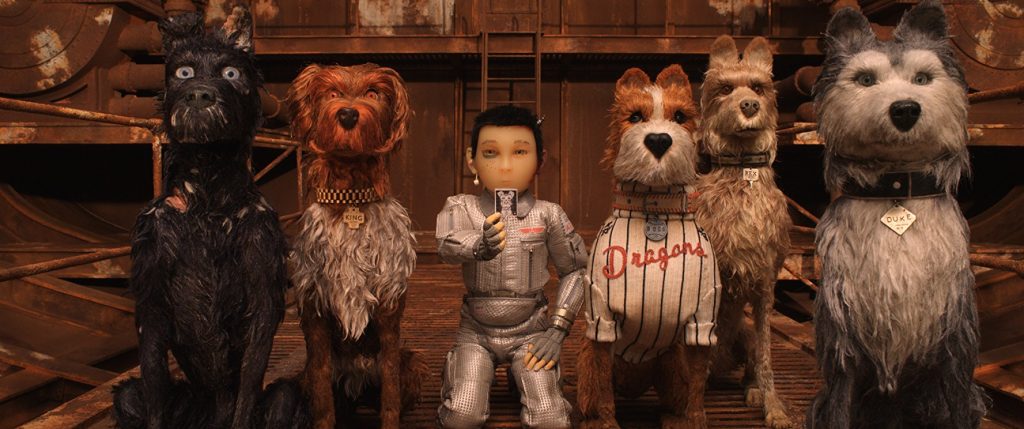
REVIEW: ‘Isle of Dogs’ is bleak and beautiful

It is commonly understood that dogs are loyal companions. Even if the title “man’s best friend” seems cliché; dogs have earned it for good reason.
Writer and Director Wes Anderson’s latest movie is sure to tug at the heartstrings of anyone who has a pet, even more so those who grew up with a dog.
“Isle of Dogs” is a stop-motion, animated film set 20 years in the future in the fictional Japanese city of Megasaki. The authoritarian Mayor Kobayashi, voiced by co-writer Kunichi Nomura, has blamed the dog population with outbreaks of “snout fever” and “dog flu” and subsequently banished all dogs to Trash Island.
The first dog sent to the toxic waste dump is Spots, voiced by Liev Schreiber. He is the personal guardian of Mayor Kobayashi’s adopted nephew Atari, voiced by Koyu Rankin. Atari steals a small plane and crash-lands on Trash Island to find Spots and the plot centers around this search-and-rescue mission. Atari is joined by a pack of former house dogs that humorously describe themselves as “scary, indestructible alpha dogs;” previously they were pampered pets.
A gruff stray named Chief reluctantly joins them after receiving advice from a former show dog named Nutmeg, voiced by Scarlett Johansson. When she asks Chief if he is going to help Atari and he responds, “No, why would I?” Nutmeg poignantly replies, “Because he is a 12-year-old boy. Dogs love those.”
The pack of dogs: Rex, Boss, Duke, King and Chief, voiced by Edward Norton, Bill Murray, Jeff Goldblum, Bob Balaban and Bryan Cranston, carry the story with their wit and emotion.
The setting for “Isle of Dogs,” a waste dump, is bleak and depressing, but Anderson renders it beautifully in his signature whimsical style. His obsessive attention to detail is evident in every perfectly placed tuft of fur and symmetrically framed shot. Additionally, the score by Alexandre Desplat is flawless, and the perfect timing and mood set by “I Won’t Hurt You” by The West Coast Pop Art Experimental Band is a musical highlight.
More so than any other Wes Anderson film, “Isle of Dogs” has political themes and looks at big-picture issues such as distrust of the government, the use of propaganda, marginalization of a group, segregation and internment. Comparisons can easily be made to the current political climate. The message conveyed by the film is the rejection of intolerance and the forms of hate that follow.
It’s not clear if the movie HAS to be set in Japan, and Anderson has received criticism for some of his filmmaking choices, including accusations of cultural appropriation.
The humans are almost all Japanese and speak in their native language, with no subtitles or dubbing, except for during newscasts where there is a UN-style interpreter. Unless a viewer speaks Japanese, the humans must be understood through tone and expressions. In contrast, a title card at the beginning of the movie explains that all barks have been translated into English.
This decision seems deliberately intended to bring the dogs and their plight to the forefront. It does so effectively, but it is at the expense of the Japanese human characters reduced to “others” to a presumed primarily English-speaking audience.
Most of the potentially problematic borrowing of Japanese culture in the film is done affectionately. Anyone familiar with Anderson knows he packs in references to other cinematic influences. Here, he specifically wanted to pay homage to great Japanese filmmakers such as Akira Kurosawa, Seijun Suzuki and Yasujiro Ozu.
Cultural appropriation should not be taken lightly when it is exploitative and disrespectful. Many elements of culture unavoidably get blended and borrowed, especially in art, and the term often gets hurled carelessly. Harmful appropriation involves a dominant culture using elements of a minority culture out of context or distorting their meaning. Anderson approaches his culture and setting choice with respect and appreciation.
The Japanese setting and aesthetic style choices in “Isle of Dogs” are a very different situation from whitewashing an Asian role, such as Scarlett Johannsson in the recent movie adaptation of anime “Ghost in the Shell” and Tilda Swinton as the Ancient One in Marvel’s “Doctor Strange.”
One thing that stuck out sorely was American foreign exchange student Tracy. She leads her classmates to investigate and expose Mayor Kobayashi and to rebel against his quarantine decree. She means well, but she seems like a clear example of the “white savior” archetype. No reason is apparent why this subplot could not have had sympathetic Japanese students leading the charge.
Besides a few questionable exceptions, “Isle of Dogs” is a touching, funny and unique film. Wes Anderson’s style is very specific, and those who do not like his previous stop-motion “Fantastic Mr. Fox” or his live-action movies may not like this one either, but maybe the dogs will win them over.
